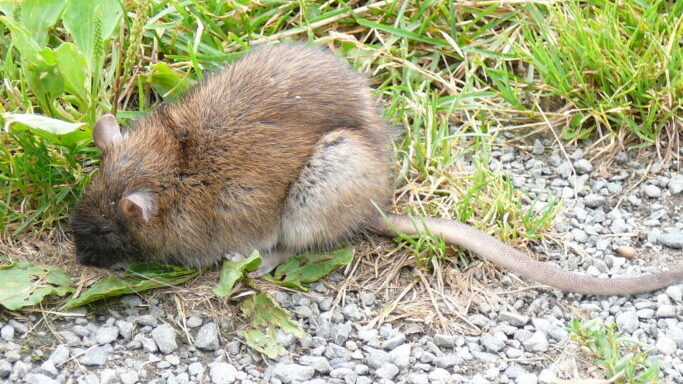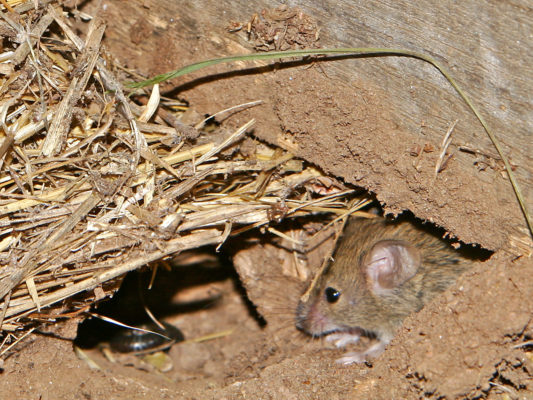It’s not quite a sugar-coated pill, but the principle is similar – a nice flavoured coating that not only encourages rodents to take the bait, but also protects the toxic cereal bait within from deteriorating over time and going mouldy. Norway rats, in particular, have been found to avoid mouldy bait.

Research recently published in the New Zealand Journal of Zoology, tests some possible options for a longer-lasting, protective coating. If a solution can be found, both labour costs replenishing bait stations and wastage costs from spoiled bait can be reduced. For community groups with limited volunteer hours and budgets where every cent counts, that could be a valuable cost-saving. It could also be of huge benefit for baiting operations at remote locations such as offshore islands where popping back regularly to check the bait stations isn’t a realistic option.
Shona Sam, James Ross, Tom Agnew, Hussam Razzaq, Carmel Woods, Nick Tucker and Elaine Murphy carried out the research and are based at a variety of research institutions: New Zealand Defence Force; Department of Ecology, Lincoln University; The New Zealand Institute for Plant & Food Research Ltd, Christchurch and United Kingdom School of Engineering, University of Lincoln, Lincolnshire, UK.
“One potential way to improve the field life of baits is by coating them in materials that reduce water uptake and subsequent mould growth. However, these coatings must be palatable to the rodents. This report investigates the palatability to captive Norway rats (Rattus norvegicus) and mice (Mus musculus) of both weathered and unweathered rodent food pellets coated with various polymer solutions.”
A polymer coating doesn’t sound that appetizing, but it’s got to be more appealing than mouldy food and, as it happens, similar techniques are sometimes used to increase the shelf-life of human food.

“Previous studies have documented the effect of long-life bait coatings on palatability amongst both wild and captive rodent subjects. Initial efforts to encase baits within tin foil and self-resealable polythene bags only increased the neophobic responses of Norway rats, thus decreasing bait palatability. Traditional wax coatings have also resulted in a decrease of palatability for wild house mice. More recently, both naturally occurring and artificially produced human food preservatives have been recommended as possible coatings for rodent baits. These preservative coatings allow for the natural characteristics of the baits relating to smell and taste to remain, whilst protecting against the development of mould and decay.”
So what exactly are these ‘polymer solutions’? They sound like something you might find at a hardware store, but apparently the practical applications for shellac and polyvinyl butyral (PVB)go well beyond adding a nice finish to wood and laminating glass.
“This research trial had two key objectives. The first was to establish whether rodent food pellets coated with various preservative coatings remained palatable when compared with their uncoated equivalents. The second was to determine whether the coated pellets remained palatable to rodents after an extended period of environmental exposure, as to make them suitable for long-term use in bait stations deployed on offshore island sanctuaries or in remote areas on the New Zealand mainland.”
And the answer was yes!
“When compared with uncoated alternatives, fresh baits coated with shellac or polyvinyl butyral (PVB) in ethanol solvent were preferred by the rats. The use of acetone rather than ethanol solvent did not affect bait palatability. A combination of shellac and PVB reduced palatability compared with shellac alone.”
What’s more, the Norway rats were still liking their non-mouldy options, after months of weathering exposure.
“Weathered shellac-coated baits remained more palatable than uncoated fresh pellets to rats for up to 6 months and outperformed the PVB and combination coatings.”
Mice proved to be a little more fastidious.
“Overall, the palatability of fresh-coated baits was lower for mice. The PVB-coated baits had lower mean palatability scores than the shellac-coated baits but none of the bait types was significantly less palatable than uncoated baits. The shellac-coated baits remained palatable to mice for up to 4 months. Shellac is recommended as a coating for multi-species rodent baits.”
Who would have thought it? Rodents prefer their bait with a coating of natural varnish? But before heading to the hardware stores for some shellac to dip your rat bait in, a word about the coating process: it’s not quite that simple! There is a degree of precision involved.
“The coating materials were selected to have low odour and low likelihood of tainting the flavour of the pellets. This was done by choosing materials that are either foodstuff grade or food contact safe. Shellac (Resene Orange flake Shellac) and polyvinyl butyral (PVB; Mowital B30HH grade, Kuraray Ltd) were used as supplied. Shellac is a natural product derived from secretions from the lac bug (Kerria lacca) and PVB is a synthetic polymer made by the transesterification of polyvinyl alcohol. Shellac has the advantage of being completely biodegradable.”
The coatings then had to be dissolved in a solvent.
“The solvent choice was dictated by considerations of processability and palatability. Acetone is highly volatile, and therefore will allow a faster manufacturing process time. Ethanol is slower to evaporate, but may have a beneficial effect on bait palatability because it has been noted that alcohol vapour (as from fermenting fruit) is used for olfactory localization of transient food sources. In either case the evaporated solvent can be recovered during the drying process and reused. This is achieved through a machine attachment that collects the solvent vapours and condenses them back to the liquid form to be reused, enhancing production efficiency. The pellets were dip coated by immersion, and then spread on trays to dry overnight under ambient conditions. This produced a transparent coating no thicker than 500 μm.”
The full research report is published in the New Zealand Journal of Zoology. Only the abstract is freely available online to non-subscribers.
Novel edible coatings to improve longevity of rodent baits (2018)

